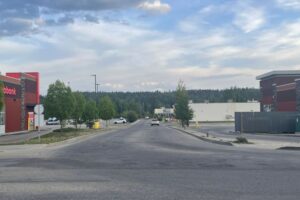A growing concern within the area continues to inch its way closer. The Mountain Pine Beetle (MPB) is a naturally occurring insect of the Rocky Mountain ecosystem and, under normal winter conditions, is normally controlled by very cold weather. In the late 1990s, according to British Columbia’s official website, several relatively warm winters caused a massive outbreak which resulted in the loss of millions of hectares of pine forest over the following 15 years.
The beetles attack mature, green trees by boring in through the bark layer and digging into the phloem which is the living tissue in vascular plants that carries organic nutrients. Over time the trees die, dry up, and become literal matchsticks in the forest. During the Monday, September 10 regular meeting, council received an update from the 2017-2018 Central-Foothills Regional MPB Summary Report which highlighted action being taken to combat the spread of MPB and where the beetles have reached.
Councillor Ray Hilts has been involved in the topic of MPB for years through his work within the forestry industry and is well versed in the area. In 2008, he and a colleague at the Alberta Newsprint Company, Jim McCammon, recognized that there wasn’t a modeling taking place nor was there a clear understanding of the impact caused by the spread of MPB. Their work over 10 years ago is the reason the Regional Summary Report exists.
They worked hand in hand to create a model that could articulate the risks and where the potential spreads might occur on an annual basis. “It was instrumental in having a better understanding and, literally, since that day the government has adopted the frame work that we created and are using it around the province,” said Hilts.
This year’s report gives news that the MPB is firmly established in both the Central and Foothills Regions and that the environmental conditions continue to support the growth of the population. The report outlines that an increased focus on Level 1 Control be implemented which concerns the removal of infested trees to help control the spread. It also states that increased Level 2 Control also be engaged which would mean harvesting in the Foothills Region to not only control spread but to also ensure reforestation as companies would cut down and then replant.
“The concern that I have, and that many other people have, is that we continue to see MPB as a significant risk to our forests and I’m not just talking from a commercial industry standpoint but from an ecological devastation standpoint.” Currently, the devastation can be seen first hand by taking a drive through Jasper National Park. “Now we’re seeing probably the worst of the worst coming through Jasper and destroying much of the pine forests there and continuing on into Alberta into the Hinton area and further straight west of Whitecourt.” Hilts said it should be a concern for everybody.
“We’re not just talking about commercial timber supply. We’re talking about fundamental changes in forest structure in terms of what you’re seeing in BC.” He said large portions of the forest in BC that have been devasted by MPB and died created a massive amount of fuel load that is susceptible to fire. “These forests and landscapes do get fires and, in this case, are nearly impossible to control and we can’t have that. The unfortunate part is that we’re there now and it’s growing. I think the report indicates that they continue to see growth of MPB in these areas that are already at critical levels,” said Hilts.
So, why the increase in MPB take over? He said there are a few factors. “Beetles are very resilient relative to cold weather and, by no means am I a biologist or entomologist, but beetles do very well if they experience warm winters. I’m told they have chemicals in their body which acts like antifreeze so they go into dormancy and it’s very difficult to kill them. When they experience a warm winter and then another it grows the population. You have to understand that these beetles can fly in the Jetstream and we saw that in BC where they literally flew halfway across the province.”
With warmer temperatures in Alberta, it helps the beetles grow their populations and adding in their ability to fly large distances means the risk extends across the province and not just to those closer to the BC border. “It’s unfortunate to see these large forest areas that are merchantable just die on the stump. It will take much longer for those areas to regenerate naturally than it would be to go in and recover some of that fibre and then plant new seedlings.” He said he hopes the National Parks are planting within the areas devastated by the beetle but said he doesn’t know if they are.
“It’s unfortunate that it has gotten to the point that it has but there are going to be devastating consequences with these massive forests that are dead. Researchers have reported levels of fire that they have never measured before because of the amount of fuel and the conditions they were burning under so, not to scare people, but this is the problem that we face now that we have this legacy,” said Hilts who is also running for the United Conservative Party West Yellowhead region. Once beetles begin to attack a tree it takes roughly a year to a year and a half for it to die. “Under the right conditions it’s nearly impossible to control those types of fires and these fires are not small, either. They end up being massive.”







More Stories
Improving the streets and sidewalks through the 2025 Street Improvement Program
Community spirit shines at large-scale youth baseball event
Birthday party chaos sung beautifully by Pumpjack Players’ youth in spring musical